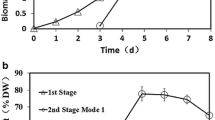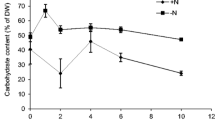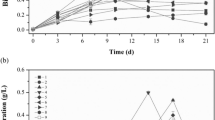Abstract
Accumulated carbohydrate in microalgae is promising feedstock for bioethanol fermentation. Selection of suitable cultivation conditions in semi-continuous cultivation is critical to achieve a high carbohydrate productivity. In the current study, the effects of macro-nutrient (nitrogen, phosphorus, and sulfur) limitations and light intensity were evaluated for the carbohydrate accumulations of Chlorella sp. AE10 under 10% CO2 conditions. It was shown that nitrogen limitation and high light intensity were effective for improving carbohydrate productivity. The average carbohydrate and biomass productivity in semi-continuous cultivation with 1/4 N medium and 1000 μmol photons m−2 s−1 was 0.673 and 0.93 g L−1 day−1, respectively. Sulfur and phosphorus limitations could improve the carbohydrate content but they could not enhance the carbohydrate productivity. The cell cycle progression and chlorophyll a were investigated using flow cytometry (FCM). The results showed that macro-nutrient limitation and high light intensity indeed influenced cell cycle progression and led to the formation of polyploid cells along with the carbohydrate accumulation in a certain range. FCM was rapid and accurate method to investigate the operation conditions why 1/4 N, 2 days as a cycle, and high light intensity were optimal ones. In addition, the remaining high level of photosynthesis activity was also important for achieving a high carbohydrate productivity. Dynamic tracking of carbohydrate accumulation is helpful for establishment of a semi-continuous cultivation for enhancing carbohydrate productivity in microalgae.





Similar content being viewed by others
Abbreviations
- Chl a:
-
Chlorophyll a
- DAPI:
-
4′,6-Diamidino-2-phenylindole
- DW:
-
dry weight
- FCM:
-
Flow cytometry
- FSC:
-
Forward scatter
- SD:
-
Standard deviation
- SSC:
-
Side scatter
- PBS:
-
Phosphate-buffered saline
- PBR:
-
Photobioreactor
References
Ruiz, J., Olivieri, G., de Vree, J., Bosma, R., Willems, P., Reith, J. H., Eppink, M. H. M., Kleinegris, D. M. M., Wijffels, R. H., & Barbosa, M. J. (2016). Towards industrial products from microalgae. Energy & Environmental Science, 9(10), 3036–3043. https://doi.org/10.1039/C6EE01493C.
Ho, S.-H., Nakanishi, A., Kato, Y., Yamasaki, H., Chang, J.-S., Misawa, N., Hirose, Y., Minagawa, J., Hasunuma, T., & Kondo, A. (2017). Dynamic metabolic profiling together with transcription analysis reveals salinity-induced starch-to-lipid biosynthesis in alga Chlamydomonas sp JSC4. Scientific Reports, 7, 45471. https://doi.org/10.1038/srep45471.
Chen, C. Y., Zhao, X. Q., Yen, H. W., Ho, S. H., Cheng, C. L., Lee, D. J., Bai, F. W., & Chang, J.-S. (2013). Microalgae-based carbohydrates for biofuel production. Biochemical Engineering Journal, 78, 1–10. https://doi.org/10.1016/j.bej.2013.03.006.
Dineshkumar, R., Subramanian, G., Dash, S. K., & Sen, R. (2016). Development of an optimal light-feeding strategy coupled with semi-continuous reactor operation for simultaneous improvement of microalgal photosynthetic efficiency, lutein production and CO2 sequestration. Biochemical Engineering Journal, 113, 47–56. https://doi.org/10.1016/j.bej.2016.05.011.
Takeshita, T., Ota, S., Yamazaki, T., Hirata, A., Zachleder, V., & Kawano, S. (2014). Starch and lipid accumulation in eight strains of six Chlorella species under comparatively high light intensity and aeration culture conditions. Bioresource Technology, 158, 127–134. https://doi.org/10.1016/j.biortech.2014.01.135.
Branyikova, I., Marsalkova, B., Doucha, J., Branyik, T., Bisova, K., Zachleder, V., & Vitova, M. (2011). Microalgae-novel highly efficient starch producers. Biotechnology & Bioengneering, 108(4), 766–776. https://doi.org/10.1002/bit.23016.
Cheng, D., Li, D., Yuan, Y., Zhou, L., Li, X., Wu, T., Wang, L., Zhao, Q., Wei, W., & Sun, Y. (2017). Improving carbohydrate and starch accumulation in Chlorella sp. AE10 by a novel two-stage process with cell dilution. Biotechnology for Biofuels, 10(1), 75. https://doi.org/10.1186/s13068-017-0753-9.
Yao, C. H., Ai, J. N., Cao, X. P., Xue, S., & Zhang, W. (2012). Enhancing starch production of a marine green microalga Tetraselmis subcordiformis through nutrient limitation. Bioresource Technology, 118, 438–444. https://doi.org/10.1016/j.biortech.2012.05.030.
Ho, S. H., Huang, S. W., Chen, C. Y., Hasunuma, T., Kondo, A., & Chang, J. S. (2013). Characterization and optimization of carbohydrate production from an indigenous microalga Chlorella vulgaris FSP-E. Bioresource Technology, 135, 157–165. https://doi.org/10.1016/j.biortech.2012.10.100.
Ho, S. H., Kondo, A., Hasunuma, T., & Chang, J. S. (2013). Engineering strategies for improving the CO2 fixation and carbohydrate productivity of Scenedesmus obliquus CNW-N used for bioethanol fermentation. Bioresource Technology, 143, 163–171. https://doi.org/10.1016/j.biortech.2013.05.043.
Wang, Y., Chiu, S. Y., Ho, S. H., Liu, Z., Hasunuma, T., Chang, T. T., Chang, K. F., Chang, J. S., Ren, N. Q., & Kondo, A. (2016). Improving carbohydrate production of Chlorella sorokiniana NIES-2168 through semi-continuous process coupled with mixotrophic cultivation. Biotechnology Journal, 11(8), 1072–1081. https://doi.org/10.1002/biot.201500270.
Zhang, Y. M., Chen, H., He, C. L., & Wang, Q. (2013). Nitrogen starvation induced oxidative stress in an oil-producing green alga Chlorella sorokiniana C3. PLoS One, 8(7), e69225. https://doi.org/10.1371/journal.pone.0069225.
de Winter, L., Klok, A. J., Cuaresma Franco, M., Barbosa, M. J., & Wijffels, R. H. (2013). The synchronized cell cycle of Neochloris oleoabundans and its influence on biomass composition under constant light conditions. Algal Research, 2(4), 313–320. https://doi.org/10.1016/j.algal.2013.09.001.
Vitova, M., Bisova, K., Kawano, S., & Zachleder, V. (2015). Accumulation of energy reserves in algae: from cell cycles to biotechnological applications. Biotechnology Advances, 33(6), 1204–1218. https://doi.org/10.1016/j.biotechadv.2015.04.012.
Donnan, L., Carvill, E. P., Gilliland, T. J., & John, P. C. L. (1985). The cell-cycles of Chlamydomonas and Chlorella. New Phytologist, 99(1), 1–40. https://doi.org/10.1111/j.1469-8137.1985.tb03634.x.
Lee, H. O., Davidson, J. M., & Duronio, R. J. (2009). Endoreplication: polyploidy with purpose. Genes & Development, 23(21), 2461–2477. https://doi.org/10.1101/gad.1829209.
Hase, E., Morimura, Y., & Tamiya, H. (1957). Some data on the growth physiology of Chlorella studied by the technique of synchronous culture. Archives of Biochemistry and Biophysics, 69, 149–165. https://doi.org/10.1016/0003-9861(57)90482-4.
Šetlík, I., Ballin, G., Doucha, J., & Zachleder, V. (1988). Macromolecular syntheses and the course of cell cycle events in the chlorococcal alga Scenedesmus quadricauda under nutrient starvation: effect of sulphur starvation. Biologia Plantarum, 30(3), 161–169. https://doi.org/10.1007/BF02878750.
Yao, C. H., Ai, J. N., Cao, X. P., & Xue, S. (2013). Characterization of cell growth and starch production in the marine green microalga Tetraselmis subcordiformis under extracellular phosphorus-deprived and sequentially phosphorus-replete conditions. Applied Microbiology & Biotechnology, 97(13), 6099–6110. https://doi.org/10.1007/s00253-013-4983-x.
Fernandes, B., Teixeira, J., Dragone, G., Vicente, A. A., Kawano, S., Bisova, K., Pribyl, P., Zachleder, V., & Vitova, M. (2013). Relationship between starch and lipid accumulation induced by nutrient depletion and replenishment in the microalga Parachlorella kessleri. Bioresource Technology, 144, 268–274. https://doi.org/10.1016/j.biortech.2013.06.096.
Vitova, M., & Zachleder, V. (2005). Points of commitment to reproductive events as a tool for analysis of the cell cycle in synchronous cultures of algae. Folia Microbiology (Praha), 50(2), 141–149. https://doi.org/10.1007/BF02931463.
Velmurugan, N., Sung, M., Yim, S. S., Park, M. S., Yang, J. W., & Jeong, K. J. (2013). Evaluation of intracellular lipid bodies in Chlamydomonas reinhardtii strains by flow cytometry. Bioresource Technology, 138, 30–37. https://doi.org/10.1016/j.biortech.2013.03.078.
Fachet, M., Hermsdorf, D., Rihko-Struckmann, L., & Sundmacher, K. (2016). Flow cytometry enables dynamic tracking of algal stress response: a case study using carotenogenesis in Dunaliella salina. Algal Research, 13, 227–234. https://doi.org/10.1016/j.algal.2015.11.014.
Hyka, P., Lickova, S., Pribyl, P., Melzoch, K., & Kovar, K. (2013). Flow cytometry for the development of biotechnological processes with microalgae. Biotechnology Advances, 31(1), 2–16. https://doi.org/10.1016/j.biotechadv.2012.04.007.
Malerba, M. E., Connolly, S. R., & Heimann, K. (2016). Standard flow cytometry as a rapid and non-destructive proxy for cell nitrogen quota. Journal of Applied Phycology, 28(2), 1085–1095. https://doi.org/10.1007/s10811-015-0642-1.
Zhang, Z., Wang, B., Hu, Q., Sommerfeld, M., Li, Y., & Han, D. (2016). A new paradigm for producing astaxanthin from the unicellular green alga Haematococcus pluvialis. Biotechnology and Bioengineering, 113(10), 2088–2099. https://doi.org/10.1002/bit.25976.
Zhou, Y., Nguyen, B. T., Lai, Y. S., Zhou, C., Xia, S., & Rittmann, B. E. (2016). Using flow cytometry to evaluate thermal extraction of EPS from Synechocystis sp PCC 6803. Algal Research, 20, 276–281. https://doi.org/10.1016/j.algal.2016.10.024.
Cabanelas, I. T., van der Zwart, M., Kleinegris, D. M., Wijffels, R. H., & Barbosa, M. J. (2016). Sorting cells of the microalga Chlorococcum littorale with increased triacylglycerol productivity. Biotechnology for Biofuels, 9(1), 183. https://doi.org/10.1186/s13068-016-0595-x.
Dashkova, V., Segev, E., Malashenkov, D., Kolter, R., Vorobjev, I., & Barteneva, N. S. (2016). Microalgal cytometric analysis in the presence of endogenous autofluorescent pigments. Algal Research, 19, 370–380. https://doi.org/10.1016/j.algal.2016.05.013.
Günerken, E., D’Hondt, E., Eppink, M., Elst, K., & Wijffels, R. (2017). Flow cytometry to estimate the cell disruption yield and biomass release of Chlorella sp. during bead milling. Algal Research, 25, 25–31. https://doi.org/10.1016/j.algal.2017.04.033.
Li, D. J., Wang, L., Zhao, Q. Y., Wei, W., & Sun, Y. H. (2015). Improving high carbon dioxide tolerance and carbon dioxide fixation capability of Chlorella sp by adaptive laboratory evolution. Bioresource Technology, 185, 269–275. https://doi.org/10.1016/j.biortech.2015.03.011.
de Winter, L., Schepers, L. W., Cuaresma, M., Barbosa, M. J., Martens, D. E., & Wijffels, R. H. (2014). Circadian rhythms in the cell cycle and biomass composition of Neochloris oleoabundans under nitrogen limitation. Journal of Biotechnology, 187, 25–33. https://doi.org/10.1016/j.jbiotec.2014.07.016.
Oldenhof, H., Zachleder, V., & van den Ende, H. (2007). The cell cycle of Chlamydomonas reinhardtii: the role of the commitment point. Folia Microbiologica, 52(1), 53–60. https://doi.org/10.1007/BF02932138.
Xie, D., Miller, E., Sharpe, P., Jackson, E., & Zhu, Q. (2017). Omega-3 production by fermentation of Yarrowia lipolytica: From fed-batch to continuous. Biotechnology and Bioengineering, 114(4), 798–812. https://doi.org/10.1002/bit.26216.
Acknowledgements
This study is supported by the National Natural Science Foundation of China (21576278).
Author information
Authors and Affiliations
Corresponding author
Ethics declarations
Conflict of Interest
The authors declare that they have no competing interests.
Rights and permissions
About this article
Cite this article
Yuan, Y., Liu, H., Li, X. et al. Enhancing Carbohydrate Productivity of Chlorella sp. AE10 in Semi-continuous Cultivation and Unraveling the Mechanism by Flow Cytometry. Appl Biochem Biotechnol 185, 419–433 (2018). https://doi.org/10.1007/s12010-017-2667-1
Received:
Accepted:
Published:
Issue Date:
DOI: https://doi.org/10.1007/s12010-017-2667-1




